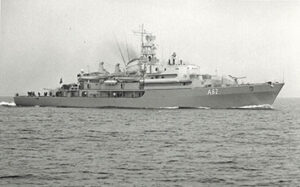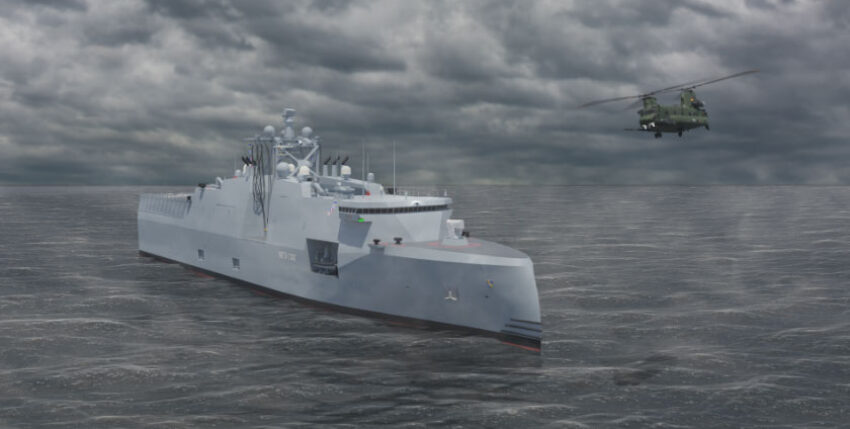The Class 404 tenders are due to be replaced in less than ten years. The navy wants the new ships to be able to take on additional tasks. The NVL shipyard has submitted an initial design on this basis.
In the target vision for the years after 2035, the naval command envisages six support units as successors to the Type 404 tenders. The modular platforms are intended to ensure "organic logistics, operational support including reconnaissance", according to the summary of tasks and capabilities in the Marine 2035+ target vision brochure. In presentations, the package is expanded by representatives of the naval command to include "amphibious, command and control, transport including casualty transport". They are also described as part of a system of a task force with and without autonomous systems.
Either way, this probably means an obvious departure from the existing concept of the Medium Support Unit afloat (MUsE). At the beginning of 2021, the framework data for MUsE was presented to the international public by a representative of the naval command at a conference in London.

From MUsE to NTV 130
With the target image published in March, the situation is different. But how? When the naval forum looked into the crystal ball, NVL came to the rescue. Using NATO's general capability descriptions (Bi-SC Agreed Capability Codes and Capability Statements), engineers and designers on the Weser drew up key points of a platform that could correspond to the support unit from the target picture based on previous utilisation experience. If you like, this design is not the result of the requirements of a potential customer. Rather, it is the result of a thought process by the manufacturer, in which he combines the idea from the target image with the experience of the industry. The NVL designers incorporated the relevant design framework conditions and the construction regulations that apply to the German Navy and took into account so-called market-available solutions.
The end result is an approach labelled Naval Tender Vessel 130 (NTV 130). It outlines an enclosed, multi-role support and logistics vessel that offers the flexibility of a large hull with internal vehicle and stowage decks, stowage space on the weather deck and additional accommodation options. The name suggests that the design is not very far removed from the MUsE in terms of dimensions.

In order to meet mobility requirements, including worldwide deployment, the diesel-electric propulsion system is designed for a cruising speed of more than 18 knots, with a minimum speed of twelve knots in force five seas. According to the NVL, the design achieves a maximum speed of 22 knots, to which the hull design contributes. Propulsion is achieved by a propeller on the shaft with a nacelle propeller behind it, both counter-rotating (contra-rotating propeller, CRP). To increase manoeuvrability, there is an extendable propeller in the bow that can be swivelled through 360 degrees.
The platform is designed for self-sufficient operation for up to 21 days. The enclosed design takes into account resistance to weather conditions during operation in northern sea areas as well as protection against NBC threats.
The NVL study comes up with a payload capacity of up to 5,000 tonnes for the transport of fuel, operating materials and supplies. This is significantly more than the Type 404 tenders and roughly double the targeted MUsE. Based on construction specification 4250-1, the Bremen-based company has provided for the ability to supply supplies, fuel and other liquids during the voyage and at sea. The RAS mast is integrated into the overall structure in order to optimise the space available for deck superstructures. A landing deck enables the accommodation of medium to heavy helicopters and corresponding utilisation options of the platform for vertical supply and medical evacuation. The hangar and ground service facilities enable maintenance and repair work to be carried out on board helicopters. The model is organically based on the NH 90 type, but the weather deck is designed to accommodate heavy transport helicopters such as the CH 47.

In terms of sensors and effectors, the NTV 130 has the appropriate means for the timely detection, identification and tracking of aerial targets by day and night and in changing weather conditions. RAM, Millennium Gun and SeaSnake are conceptually provided for self-protection. A suitable sonar should enable mine detection. Even torpedo defence has been considered and the design takes into account the integration capability for corresponding torpedo decoys or sonar jammers. Accordingly, the command and weapon deployment system should be designed to be able to react to the various threats. The aim is to optimise the signatures through constructive means and appropriate precautions during the design phase.
The fundamental use of unmanned systems formulated in the target image is taken into account. The NTV 130 includes deck storage compartments, hangars and system-optimised launch and recovery devices as well as integrated and modular control stations.
Modulable multi-roll capability
What is groundbreaking is the guarantee of genuine modularity, which offers potential for future expansion in addition to a position-dependent configuration of the platform. A container-based loading concept similar to The Cube from SH Defence, including a high degree of automation, enables the integral but also mixed use of the capabilities to be combined according to the mission - either just a supply ship or a command platform with intervention capability. The design of the NTV 130 achieves multi-role capability. It ranges from the embarkation capacity for a unit of mechanised infantry including accommodation capacity for additional personnel to the fitting of control elements for the use of drones on and under water and in the air (USVs, UUVs and UAVs) through to use as a hospital ship. As a tender, the NTV 130 can therefore serve all units of Operational Flotilla 1.
As a platform, the NTV 130 combines the basic capabilities of a naval vessel (General Purpose Maritime Vessel) with the limited capabilities of a military auxiliary ship (Naval Warship Limited) and combines these with capabilities from the domains of command and control (Naval Commander Task Group - Surface), support (Logistic Ship Small) and action (Amphibious Ship Small). The respective configuration is determined by location and mission.

put into service, photo: Bw
The NTV 130 represents an attempt by a German shipbuilder to give shape to an element listed in the navy's target image. Bremen's vision is not the only one: Hamburg University of Technology and MTG also have a project in the pipeline.
The financing remains open. As far as the editorial team is aware, there is no budgetary backing for such a project. This poses a problem for research and development. The plan was once to replace the Tender 404 from 2029. The CPM document "Capability Gap and Functional Requirement" for MUsE is said to have been drawn up and signed. This raises the question of the extent to which the Ministry of Defence agrees with the Navy's ideas.
Ergo: There is a lot to do. A timely, close dialogue between the navy, industry and the procurement authority would be desirable.
Hans-Uwe Mergener









One Response
We received this letter by e-mail from a dedicated reader of Marineforum, which we would like to share with you here online with the consent of our loyal subscriber:
"Dear editors of Marineforum, thank you for the article by Uwe Mergener about the new tenders. I had a few questions while reading it.
- Is the term tender appropriate for this project? With three remaining boat squadrons, there is obviously no need for six squadron tenders. The ships also appear to have a completely different mission profile.
- This task profile includes carrying drones, helicopters and other equipment, as described in the Marine 2035+ target vision. However, I can hardly see any possibilities for larger floating systems in the design presented. You would need a well deck for that.
- The only capacity for the aforementioned amphibious task seems to me to be the landing option for heavy helicopters, which, however, cannot be embarked permanently. I don't see any landing craft that can carry more people and material in one transport than helicopters can in many flights.
- If a ship is equipped with various small systems, they must be managed. Simply taking them along is not enough to use them sensibly in combination. A corresponding guidance system is not mentioned in the article. My request to the editorial team is to stay on top of this topic and keep us readers up to date on the issues mentioned."
We'll stay tuned, Mr Kayat.